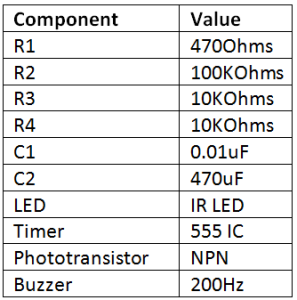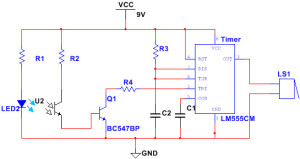AUTOMATIC DOOR BELL RINGER
Automatic Door Bell Ringer
Have you ever wondered how easy it would be if you go to someone’s place, and the person there opens the door without you even pressing the bell,or if you have reached your home from office,very tired and moved towards the door quite close to it, and the bell inside rings suddenly, and then someone opens the door, and you enter without even pressing the door bell.
You might be thinking that this looks like a dream or illusion, but it is not like that; it’s a reality which can be achieved with a few basic electronic circuits. All that is needed is a sensor arrangement and a control circuit to trigger an alarm based on the sensor input.
Components Required
Circuit Connection
The sensor used is, an IR LED and a photo transistor arrangement,placed adjacent to each other. The output from the sensor unit is fed to the 555 Timer IC through a transistor and a resistor. The input to the timer is given to the pin 2.
The sensor unit is supplied with a voltage supply of 5V, and the timer IC pin 8 is supplied with a Vcc supply of 9V. At the output pin 3 of the timer, a buzzer is connected. The other pins of the timer IC is connected in a similar manner so that the timer operates in a mono-stable mode.
Circuit Diagram
Circuit Operation
The IR LED and the photo transistor are placed near such that, in normal operation, the photo transistor doesn’t receive any light and doesn’t conduct. Thus, the transistor
(as it doesn’t get any input voltage) doesn’t conduct.
Since the timer input pin 2 is at logic high signal, it is not triggered and the buzzer doesn’t rings, as it doesn’t receive any input signal.If a person approaches the door, the light emitted by the LED is received by that person and gets reflected back. The photo transistor receives this reflected light and then starts conducting.
As this photo transistor conducts, the transistor gets biased and starts conducting too.The pin 2 of the timer receives a low logic signal and the timer gets triggered. As this timer gets triggered, a high logic pulse of 9V is generated at the output, and when the buzzer receives this pulse, it gets triggered and starts ringing.


Comments
Post a Comment